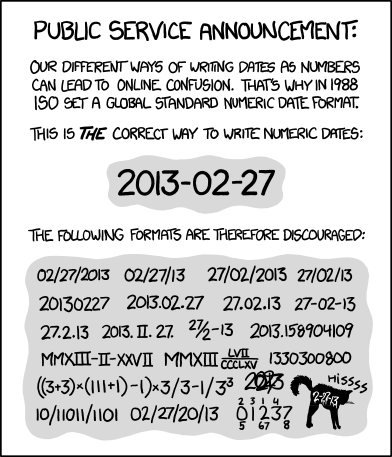iso-8601: Difference between revisions
m (Replace <entry-title> with {{DISPLAYTITLE:}}) |
|||
| (One intermediate revision by one other user not shown) | |||
| Line 1: | Line 1: | ||
{{DISPLAYTITLE:ISO 8601}} | |||
The '''International Standards Organisation''''s standard, number '''8601''' is an international standard for date and time representations. It is used for all date-time representations in microformats, as well as a number of other formats ([[HTML5]] <code><time></code> element & <code>datetime</code> attribute, XML Schema Datatypes, RDF, Atom). | The '''International Standards Organisation''''s standard, number '''8601''' is an international standard for date and time representations. It is used for all date-time representations in microformats, as well as a number of other formats ([[HTML5]] <code><time></code> element & <code>datetime</code> attribute, XML Schema Datatypes, RDF, Atom). | ||
| Line 40: | Line 40: | ||
* Ruby 1.9 implements an iso8601 method in the Date STDLIB but it does not handle ordinal dates. | * Ruby 1.9 implements an iso8601 method in the Date STDLIB but it does not handle ordinal dates. | ||
* Glenn Jones' [https://github.com/glennjones/microformat-node microformat-node] parser includes isodate.js, a Node.js implementation of (some of) ISO 8601. | * Glenn Jones' [https://github.com/glennjones/microformat-node microformat-node] parser includes isodate.js, a Node.js implementation of (some of) ISO 8601. | ||
* Python: [https://pypi.python.org/pypi/iso8601 iso8601] | |||
{{ToDo}} document more implementations. | {{ToDo}} document more implementations. | ||
Latest revision as of 16:28, 18 July 2020
The International Standards Organisation's standard, number 8601 is an international standard for date and time representations. It is used for all date-time representations in microformats, as well as a number of other formats (HTML5 <time> element & datetime attribute, XML Schema Datatypes, RDF, Atom).

Image: XKCD
In addition, ISO 8601 dates in particular are the most globally unambiguously human readable/writeable date format and thus should always be used on the (world wide) web.
Overview
The following are good prose overviews of ISO 8601:
Microformats
microformats in general use a subset of ISO8601 - preferring uses which are more human readable (requiring hyphens in dates, and colons in times).
All date-time properties in microformats use ISO8601 values. E.g.
- all
dt-*properties in microformats2 - all classic microformats's date-time properties, including:
HTML5
HTML5 uses both a subset of ISO 8601 for dates, times, durations for the <time> element, as well as an extended (and more human friendly) duration format.
RFC 3339
RFC 3339 defines a profile of ISO 8601 for the use in Internet protocols and standards.
- It explicitly excludes durations and dates before the common era.
- The more complex formats like week numbers and ordinal day are not permitted (see RFC 3339, section 5.6).
ISO 8601 implementations in programming libraries
- JodaTime - the Java date-time library - ISO8601 Java calendar system
- Perl: DateTime::Format::ISO8601
- Ruby 1.9 implements an iso8601 method in the Date STDLIB but it does not handle ordinal dates.
- Glenn Jones' microformat-node parser includes isodate.js, a Node.js implementation of (some of) ISO 8601.
- Python: iso8601
to do! document more implementations.
FAQ
Why hyphens in dates
Q: Must I use the hyphens?[1]
A: You should always use hyphens in ISO 8601 dates because that makes them more readable, and thus more human friendly.
Also, using hyphens helps clearly distinguish different uses for different granularities of dates, e.g.:
- 2013-08-19 - just the day
- 2013-08 - the whole month
- 2013 - the entire year
Issues
None currently.
Resolved issues: iso-8601-issues-resolved.
See also
- ISO 8601 on Wikipedia
- ISO 8601:2004(E) from ISO (zip-pdf, 228KB)
- Summary of 8601 by ISO
- Technical Committee ISO/TC 154, Processes, data elements and documents in commerce, industry and administration.
- The Mathematics of the ISO 8601 Calendar
- Current date in week date and ordinal date format
- ISO 8601 at the Open Directory Project
- W3C Specification about UTC Date and Time and IETF Internet standard RFC 3339, based on ISO 8601
- StackOverflow: iso-8601 tag - questions about iso-8601 as related to JavaScript, PHP, MySQL and other programming languages and technologies.